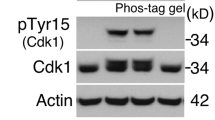Abstract
Cell cycle progression is regulated by cyclin-dependent kinases (cdks). The activity of cdks is tightly controlled by several mechanisms, including binding of subunits to cdks (cyclins and inhibitors), and phosphorylation events. This review focuses on the activating phosphorylation of cdks by an enzyme termed cdk-activating kinase (CAK). Two classes of CAKs have been identified monomeric Cak1p from budding yeast and the p40MO15(cdk7)/cyclin H/MAT1 complex from vertebrates. Cak1p is the physiological CAK in budding yeast and localizes to the cytoplasm. p40MO15(cdk7)/cyclin H/MAT1 localizes to the nucleus, is a subunit of the general transcription factor IIH and activates cdks as well as phosphorylates several components of the transcriptional machinery. Functions, substrate specificities, regulation, localization, effects on cdk structure and involvement in transcription are compared for Cak1p and p40MO15 (cdk7).
Similar content being viewed by others
Author information
Authors and Affiliations
Additional information
Received 14 September 1998; received after revision 2 November 1998; accepted 2 November 1998
Rights and permissions
About this article
Cite this article
Kaldis, P. The cdk-activating kinase (CAK): from yeast to mammals. CMLS, Cell. Mol. Life Sci. 55, 284–296 (1999). https://doi.org/10.1007/s000180050290
Published:
Issue Date:
DOI: https://doi.org/10.1007/s000180050290




